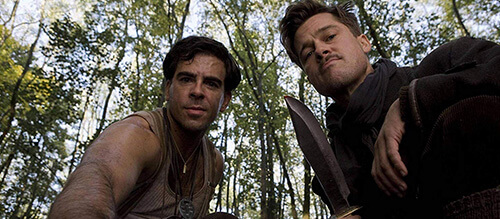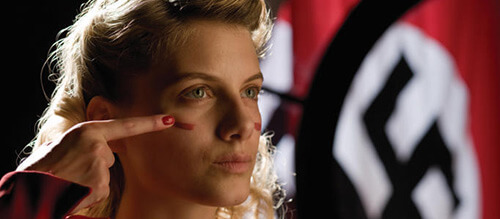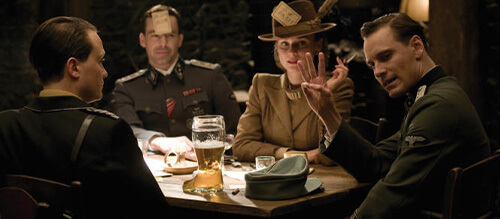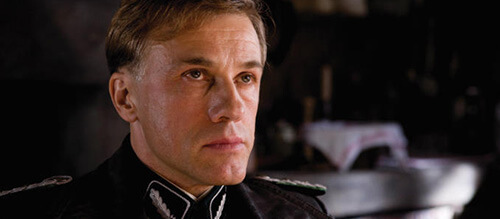It Just Might be His Masterpiece: Revisiting Tarantino’s ‘Inglourious Basterds’ Ten Years Later
This article was written exclusively for The Film Magazine by Samuel Sybert.
Quentin Tarantino’s highly anticipated Once Upon a Time… In Hollywood hit the big screen at Cannes 2019 and was met with a seven minute standing ovation. The early reviews for the legendary director’s 9th film are so overwhelmingly positive that the existential question being asked since 1994 may finally be answered: “will Tarantino ever top Pulp Fiction?”
Whispers that Hollywood may have accomplished this feat have begun swirling around the ears of the film world, making the time until the movie’s July 26th release date even more torturous to endure. However, if you were to tell me I’d need to wait that long to watch Quentin outshine his famous 2nd film, I’d tell you to hop into a time machine and go back to August 21st, 2009; the day Inglourious Basterds hit theatres.
Inglourious Basterds is set against the backdrop of Nazi occupied France during WWII. The film centers around a small group of rag-tag Jewish American soldiers, led by a no-nonsense southern lieutenant named Aldo Raine (Brad Pitt). Raine’s first appearance has him debrief his command of their objective behind enemy lines: “We’re gonna be doing one thing, and one thing only: killing Nazis.” Pitt’s character, like most, possesses a visceral hate for anyone in a Nazi uniform. In fact, his disdain for Hitler’s foot soldiers borders on the cruel as he instructs his men that they each personally owe him a whopping one hundred Nazi scalps. Even this horrendous order may seem relatively tame by Tarantino standards (especially following his shockingly violent 2007 movie Death Proof and the Kill Bill films), but nevertheless, the stage is set for a good old Tarantino blood bath featuring the epitome of evil on the other end of a Louisville Slugger (yeah, a crazed Eli Roth brutalizes a Nazi captain with a wooden baseball bat). Ironically, despite the in-your-face gratuitous violence that has become a staple of a Tarantino film, the true genius of Inglourious Basterds lies in the subtleties etched on the faces, and in the words, of its characters.
Besides Lt. Aldo Raine and his squad, Basterds features other characters of great importance. The most prevalent of these is the intimidating yet darkly hilarious Nazi Colonel Hans Landa (Christoph Waltz) – Waltz would take home a supporting actor Oscar for his brilliant performance as the villain, and rightly so. There is also Shoshanna Dreyfus (Melanie Laurent), a young Jewish woman who escaped the massacre of her family at the hands of Landa to inherit a small cinema in Paris. Shoshanna, under the alias of “Emmanuel Mimieux”, resists the charms of a smitten Nazi war-hero named Frederick Zoller (Daniel Bruhl), who is determined to win her heart. In a small French café, Zoller tells Shoshana of his exploits: while alone in a walled off city, he was able to kill over two hundred enemy soldiers from a bell tower. We also are told that the Nazi propaganda master Joseph Goebbels (Sylvester Groth) made a film about the event starring Zoller himself, titled ‘Nation’s Pride’. Where things get interesting is when, at lunch, Zoller convinces Goebbels to host the premiere of ‘Nation’s Pride’ at Shoshanna’s tiny movie theatre. Clearly seeing this as her time for revenge against the animals that killed her family, Shoshanna conspires with her employee (and lover), Marcel (Jacky Ido), to burn down the cinema on “Nazi night”.
Re-enter Aldo Raine and his men.
With the help of a German speaking British soldier (Michael Fassbender) and the double agent German movie star Bridget von Hammersmark (Diane Kruger), the Basterds are given the task of blowing up the movie theatre at the premiere of ‘Nation’s Pride’, completely unaware of Shoshanna’s similar intentions. The stage is set for a blow out of a finale. At the risk of revealing too much, I will only say that the all too familiar “plans gone wrong” narrative weaves its way into yet another Tarantino movie, until we are left with just three characters alone in the woods after the ‘Nation’s Pride’ premiere goes up in flames.
The way scenes unravel in Basterds is what keeps eyes glued to the screen. Rather than raising the stakes with a shock factor, Tarantino uses the power of his characters’ words and facial expressions to slowly create tension that could be cut with a knife. Only at the peak of this pressure does Quentin allow the explosion of violence, like a delicious slice of cheesecake after a perfectly cooked prime rib. There is one particular scene that perfectly illustrates this method, and it involves Fassbender and Kruger’s characters undercover with 2 of the “Basterds”.
Disguised as Nazis, our four heroes find themselves surrounded by real German soldiers in a tavern basement. There are no less than four small moments in this scene through which Tarantino raises the stakes, each one pushing us closer to the edges of our seats. The first is when the Basterds arrive to the tavern. Their assignment is to make contact with their undercover agent, Bridget von Hammersmark. No Nazis were supposed to be present, but it turns out this little bar is full of them on this particular night. Tarantino has placed his characters in an uneasy situation, and he wants you to know it. Now they must work twice as hard not to compromise their identities. The second moment comes when one German soldier (August Diehl) questions Fassbender’s accent. Because we as the audience know that he’s actually British, a Nazi questioning his dialect puts the group further in the danger zone. But Fassbender is able to talk his way out of it, and the scene plays on.
We can relax for a moment until Diehl’s character asks Fassbender where he is stationed, as Diehl has never heard of him before and he “knows every German stationed in France”. In a second wave of relief, Fassbender’s character manages to talk his way out of trouble again. Finally, just when we thought we were out of the woods, he makes a small hand gesture that completely gives away his identity. What’s interesting, though, is that when the gesture is made, the Nazis don’t just stand up and start shooting. Tarantino centers his camera on the face of August Diehl, who locks eyes on the hand of Michael Fassbender. His face darkens, and he stares daggers at those three fingers…but he says nothing. Without using a single word, Tarantino is able to tell us with a simple close-up that something is horribly wrong; we just don’t know what it is. The Nazi pretends as though everything is normal until he reveals that he knows Fassbender is a phony, and that there’s no chance of either one of them leaving the basement alive. In this moment, Tarantino once again uses the power of his close-up: Michael Fassbender realizes he is a dead man, and his eyes speak louder than any words possibly could.
Quentin Tarantino masterfully times his close-up shots. Just like in instances above, he often uses them to convey his characters’ emotions right before the climax of a scene. In just a few seconds, the director allows us to analyze the happiness, anger or anguish of a person when they know a life-changing moment is on their doorstep. Christoph Waltz’s award winning performance is heavily reliant upon this method, as his mostly caricatured Colonel Hans Landa has some of his best moments with only his face in the frame.
By the same token, the density of the scripted words and actions is the heart and soul of Inglourious Basterds, so much so that attempting to find too much meaning in the story would do the film a great disservice. Some audience members won’t have the patience for this method of story-telling, as they will be ignoring the so called “throw away dialogue” while waiting for the scene to “get to the point”. Those people have, in fact, already missed it. The screenplay for Basterds is pristine, and even more detailed and delightful than that of Tarantino’s magnum opus Pulp Fiction. Yet, like Pulp, Tarantino allows it to play out over time. He even changes the face of history with his ending, and if you’re wondering if he cares whether or not you think it’s too bold, I can assure you: he does not.
The alternative history Basterds presents goes hand in hand with Tarantino’s most authorial stamp of subverting cinematic norms and satirising disgusting behaviour so as to remove its power. This is perhaps no more clearly evident than in this movie: there are numerous pop-culture references littered throughout, mostly about the German and French film industries under occupation of the Third Reich; time appropriate observations of directors such as the misunderstood Leni Riefenstahl and famed G.W. Pabst are seen from different points of view; we are also subject to many musical numbers that even sometimes make us uncomfortable, as their tones don’t exactly match up with the actions on screen. As for satire, Tarantino takes aim at the Nazi party. Though he keeps a menacing air about the Nazis as to not let us forget the truth, he also allows us to laugh at them, which feels really, really good. Goebbels is portrayed as somewhat of an idiotic weasel, and Hitler himself (Martin Wuttke) is too much fun to hate.
Conclusively, Inglourious Basterds, though sometimes awkward and rough around the edges, is a monumental achievement. Tarantino creates a giant melting pot of characters, each and every one with their own agenda, and places them in one of the most pivotal times in world history. As Aldo Raine stares down the blade of his shiny knife after carving a swastika into the head of a Nazi, he states that “it just might be his masterpiece”. These words ring clear as the credits role, and if he was speaking for Tarantino, I couldn’t agree more.
Written by Samuel Sybert
[DISPLAY_ULTIMATE_SOCIAL_ICONS]





